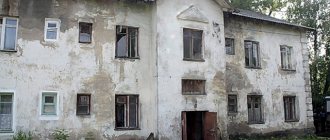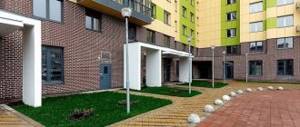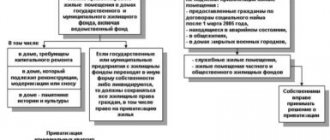One of the most painful problems of many Russian cities is the large number of dilapidated and dilapidated housing.
Such houses have not undergone major repairs for years, and they are on the verge of destruction, which threatens not only enormous damage to the locality, but also loss of life. In addition, old buildings with cracked and faded facades negatively affect the appearance of the city.
Taking this into account, the government has developed a special “Housing” program aimed at relocating citizens from buildings that are considered dilapidated and unsafe. This project was launched back in 2002 and was planned to last until 2010.
But not all regions managed to cope with the assigned tasks, so the initiative was extended until 2020. But this was not enough, because the problem of dilapidated housing was never solved. Based on this, a new program will come into force in 2020, which should help correct the current situation.
Timing and essence of the project
When the citizen resettlement program was first created, it was planned that within 8 years all citizens living in unsafe and dilapidated buildings would find new comfortable housing. But achieving this goal turned out to be much more difficult than it seemed, so the project was extended until 2020.
As part of the program, local authorities must create a special list of real estate that falls under the criteria of being dilapidated or in disrepair. Next, the condition of these buildings is checked by the Interdepartmental Commission, which assesses the degree of damage to the building structure, and also determines whether a particular house is suitable for habitation.
[ads_middle_center]
Based on the results of the inspection, the commission makes a decision regarding the fate of the building. If the condition of the property can still be improved, then it will undergo reconstruction, and if it is on the verge of destruction, demolition and relocation of residents to other apartments.
As for the new housing, it must be equivalent in size to the old one, and also have all the necessary communications (installed plumbing, stove, working sewage system, etc.).
It is worth noting that in fact only residents of emergency buildings have the opportunity to move. Dilapidated buildings, most often, are only reconstructed, carrying out major repairs.
List of addresses and relocation schedule by district
Eastern Administrative District (EAO) South-Eastern Administrative District (SEAD) Western Administrative District (ZAD) South-Western Administrative District (SWAD) Northern Administrative District (NAD) North-Eastern Administrative District (SVAD) North-Western Administrative District (NWAD) Southern Administrative District (SAO) Troitsky and Novomoskovsk Administrative District (TiNAO) Central Administrative District (CAO) Zelenograd Administrative District (ZelAO)
By the way, the relocation plan for renovation may be further adjusted depending on the progress of construction and other conditions.
Which buildings are considered unsafe?
According to the legislation that governs the program, buildings that are at least 70% worn out are considered uninhabitable. The facility is recognized as unsafe or dilapidated by decision of the Interdepartmental Commission.
It is worth noting that the department only inspects buildings included in the relevant list, but residents of a dilapidated building can initiate an inspection themselves if they collect a sufficient number of written requests and the necessary package of documents.
An object is recognized as unsafe, and therefore unsuitable for human habitation, if:
- its walls or foundation are deformed;
- it is located in an avalanche or flood zone;
- it is on the verge of collapse;
- its load-bearing capacity is damaged due to natural disasters, fires, etc.;
- it was destroyed due to a man-made disaster.
As already noted, only citizens who live in dilapidated houses have a chance of resettlement. If a residential property is considered dilapidated, then its residents can only count on reconstruction, which in most cases only delays the destruction of the building for several years.
But if a dilapidated house has a high degree of deterioration, then it may be “sentenced” to demolition, which also gives citizens the right to resettle.
How did you decide when to schedule the resettlement?
Before approving the relocation order, the authorities compared many points:
- the presence of vacant land plots near the house that meet all the renovation requirements of Sergei Sobyanin;
- compliance of the selected territory with the requirements of urban planning, sanitation and epidemiology, safety and ecology;
- transport accessibility of the land plot;
- the ability to design a sufficient number of parking spaces;
- the ability to ensure the resettlement of various categories of citizens who are entitled to apartments of different sizes;
- the opportunity to implement a mechanism for additional purchase of space if the resettlement participant has such a need.
Additionally, for the resettlement schedule, the readiness of old houses for demolition was assessed - whether they can be disconnected from utility networks in a short time, or whether reconstruction is necessary. Houses that meet all conditions are included in the first stage of resettlement.
How to participate in the resettlement program
If the residents of the house believe that the building is unsafe and poses a threat to their lives, they must contact the local authorities with a corresponding statement. Local government authorities will consider the appeal and refer applicants to a special organization that determines the condition of residential properties. There, experts will give an opinion on the technical characteristics of the building.
[ads_middle_center2]
After this, residents need to contact the Interdepartmental Commission, which will conduct a final examination of the house.
To initiate an examination, you will have to collect a package of documents, which must include a house plan, copies of ownership documents, a building registration certificate, a specialist’s conclusion about the condition of the building, as well as written complaints from citizens living in the house.
If everything is in order with the documents, the commission will conduct an inspection and make a decision on it within 30 days. But in cases where the condition of the house threatens people’s lives, a decision will be made within 1 business day. It happens that the department does not recognize the object as unsafe, but the residents of the building can challenge this decision in court.
Moving schedule for renovation in Moscow
So, the renovation will take place in three stages:
- 2020-2024: resettlement of almost 200 thousand people from 930 old houses;
- 2025-2028: second wave, more than 1,500 houses to be demolished and more than 300,000 people;
- finally, almost 400 thousand more residents of the capital from 1,800 houses will move from 2029 to 2032.
Some buildings (688 apartment buildings) were left without specific time periods. Decisions on them will be made in accordance with the approval of urban planning documents. The approximate publication date is scheduled for the 1st quarter of 2021.
Where are “emergency” residents resettled?
If the commission recognizes that the house is really in disrepair, then local authorities must provide residents with new square meters, and as soon as possible.
The housing into which people will be moved must be equal in size to the old one, and also have all basic communications: water supply, sewerage, electricity, etc.
IDPs will be offered three real estate options at once, but no one will take into account the individual wishes of citizens. This means that the new apartment may be located in an area undesirable for residents or have an inconvenient layout, from their point of view, but these complaints will not be taken into account.
As for the footage of new housing, it will be calculated in accordance with legally accepted standards. So, each person should have at least 18 m2. If, upon relocation, a family claims to improve their living conditions, then it will receive housing of the required size. The authorities must complete the resettlement of citizens within a year from the adoption of the relevant decision.
If a family does not want to move into the proposed housing, then it can receive monetary compensation instead of real estate, for which it is necessary to write a special application. But in most cases, the amount that can be obtained is too small compared to the cost of the apartment, so this solution is rarely profitable.
The program for relocating citizens from dilapidated housing is a project that really works and helps many Russians get safer and more comfortable living conditions. It will also be in force in 2020, and it is likely that the authorities will extend it for an even longer period.
Privatization of communal apartments
In this case, the object of privatization is a residential premises, an apartment as a whole. Citizens' shares in the right of common ownership of a communal apartment are determined in the agreement in proportion to the area of the rooms they occupy. After concluding a transfer agreement, state registration of the right of shared ownership of the entire communal apartment is carried out in accordance with the established procedure. Such privatization of communal apartments was previously allowed in accordance with Art. 4 of the Law on Housing Privatization.
Since the object of privatization in this case is the entire communal apartment as a whole, privatization can only be carried out upon the application of the persons occupying all the rooms in the apartment.
It is important that one gratuitous transfer agreement must be signed by all participants, since shared ownership according to clause 4 of Art.
244 of the Civil Code of the Russian Federation arises when one object becomes the property of several persons, and according to clause 1 of Art. 245 of the Civil Code of the Russian Federation, shares in the right of common ownership (other than equal) are established by agreement of the participants. The number of original copies of the agreement may correspond to the number of privatization participants, since each of them has the right to have a title document confirming the presence of a share in the ownership of the apartment as a whole. The agreement may also stipulate the existing procedure for using the apartment, i.e. it is indicated who owns and uses which room (Article 247 of the Civil Code of the Russian Federation). A privatization agreement signed by only one participant is illegal, since the citizen was the tenant of the residential premises, but not a share in the common property right. The object of privatization can be rented residential premises: either a communal apartment as a whole, or a part of it, consisting of one or more rooms.
The change in the moment of acquiring ownership of privatized housing by Federal Law N 54-FZ significantly changed the registration procedure. Until May 31, 2001, citizens who privatized housing as shared ownership could apply to the justice institution independently of each other, since they became owners from the moment the agreement was registered with the local administration. Currently, it is necessary that all citizens simultaneously apply to the Main Directorate of the Federal Registration Service for registration of shared ownership rights. From the moment of registration, the apartment passes from state to private ownership: ownership of one object passes from the state to citizens, who have a single right of common ownership of this object (clause 4 of Article 244). State registration of the rights of only one of the owners cannot be carried out without registering the rights of the others.
For greater clarity, let's give an example:
Let's say an apartment is privatized by three residents in equal shares, but one of them evades registering the transfer of rights; it is impossible to register the rights of only two owners for 2/3 shares in the right. At the same time, it cannot be said that the transfer of rights to 1/3 of the share did not occur, and it remained in state ownership. During privatization, not every citizen is given a 1/3 share, but the whole thing - an apartment - is transferred into the ownership of three persons, and ownership of it can only arise simultaneously. Citizens who signed one agreement together are required to simultaneously submit an application and documents necessary for state registration. Otherwise, their actions can be regarded as evasion of state registration, the cases of which are established in paragraph 3 of Art. 165 and paragraph 3 of Art. 551 Civil Code of the Russian Federation.
It is also impossible to carry out state registration of the transfer of rights if at least one of the participants in the privatization of the owners died before the state registration. Due to the loss of legal capacity of one participant, registration of shared ownership rights will be denied to all others. Since privatization (transition to private ownership) will not take place in this case, citizens have the right to conclude a new privatization agreement with a new set of participants.
Documents for your peace of mind
When resettling people living in the premises on the basis of a social tenancy agreement or owners who wish to obtain another living space, the list of documents includes:
- A written application with a request to provide an apartment out of turn;
- Technical passport for checking the area and rooms in the apartment;
- Documents confirming ownership or rental of housing;
- Written consent of the spouse and the guardianship service (if children under 18 years of age live);
- Payment book, which contains confirmation of timely payment of utilities;
- Document on acceptance and transfer of real estate.
To receive payment, the owner must have the following documentation with him:
- Certificate of ownership;
- Declaration of choice to receive money;
- A substantive document confirming the procedure for purchasing real estate;
- Papers and receipts that confirm the amount spent on moving;
- Certificate about the number of people registered, family composition and absence of debt for utility services;
- Bank agreement on opening a current account;
- If no agreement has been reached on the state valuation of the property, then provide an appraiser’s opinion on the apartment;
- Written consent of the spouse and the guardianship service (if children under 18 years of age live);
- Passport of a citizen of the Russian Federation.
The program for relocating communal apartments in Moscow is designed to improve the living conditions of citizens and protect their health and life.
St. Petersburg is a city of bridges, white nights and communal apartments
Limited funding and bureaucratic hiccups are the first things people complain about. But the reasons for the problem are much more diverse. Where do so many communal apartments come from? They appear during divorces, when former spouses, due to the impossibility of resolving the issue of separate housing, continue to coexist in the same area. Or when real estate is inherited by several people who are forced to move in together. Communal apartments in a collapsing building are not the only option; they have also begun to appear in new buildings: people who do not have the funds to buy a separate apartment are turning to the primary market, purchasing housing on the outskirts by sharing.
List of communal apartments subject to resettlement
All residents of a communal apartment (family) must submit to the district administration at the location of the communal apartment an Application for inclusion of a communal apartment in the List (issued by the administration), and also submit the following documents: copies of identification documents of the applicants (passport, birth certificates); documents containing information about the composition of the applicant’s family (children’s birth certificates, marriage certificates or divorce certificates); documents confirming the grounds for the applicants’ possession and use of residential premises.
In this discussion topic you can ask questions regarding the program “Resettlement of communal apartments in St. Petersburg”. You can also use the “Ask a Question” service and address any questions you may have to the employees of the department of resettlement of communal apartments of the St. Petersburg State Budgetary Institution “Gorzhilobmen”. To do this, you need to follow the link: https://obmencity.ru/state/zadat_vopros/. In the subject of the letter, select “Resettlement of communal apartments” and fill out all fields of the form.








